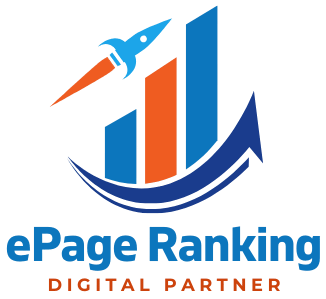
In digital marketing, visibility is everything. But how do you measure visibility before the click happens? The answer lies in organic search impressions—a metric that often flies under the radar, yet reveals how often your website appears in search results for relevant queries.
For businesses looking to grow online without depending entirely on paid ads, improving organic impressions is a strategic move. At Epage Ranking, we help brands understand and harness the power of SEO—not just for clicks, but for long-term digital presence.
Let’s break down what organic impressions are, how to track them, and what you can do to boost them in a meaningful way.
What Are Organic Search Impressions?
An organic search impression occurs each time your website appears in the search engine results page (SERP) for a user query—even if the user doesn’t click on it. Unlike paid ads, organic impressions come from your site’s relevance and ranking through search engine optimization (SEO), not through a media budget.
Think of it like this: if someone Googles “web design company in Dubai” and your site shows up on page one, that’s an impression—even if they scroll past. While a click is ideal, every impression increases your brand’s visibility and builds familiarity over time.
Why Do Organic Impressions Matter?
- Brand Awareness Without the Cost
Organic impressions are free visibility. Over time, repeated appearances in search results build brand recognition, even among users who don’t click right away. - Early Signals of SEO Performance
Before clicks and conversions, impressions show how often Google is matching your site with relevant user queries. If impressions are increasing, your SEO strategy is likely moving in the right direction. - Content Reach Evaluation
Impressions help you understand how your blog posts, landing pages, and product pages are performing in search. A high-impression but low-click page could indicate a need to improve meta titles or descriptions.
How to Track Organic Search Impressions
You don’t need expensive tools to track impressions. These two free platforms offer all the insights you need:
1. Google Search Console (GSC)
The most accurate and direct way to track organic impressions is through Google Search Console. Once your site is verified, you can access the Performance tab to view impressions, clicks, average position, and CTR (click-through rate).
Key Metrics to Check:
- Total Impressions: Overall visibility in search.
- Pages with Highest Impressions: See which pages are being shown most often.
- Queries: Keywords that triggered your website in search.
- Devices & Locations: Know where and how users are seeing your site.
Use filters by date range, device, country, or keyword to get deeper insights.
2. Google Analytics (GA4)
Although GA4 does not directly show “impressions,” you can integrate it with GSC to get a more complete view. This helps when analyzing how impressions correlate with sessions, bounce rate, or conversions.
How to Improve Organic Search Impressions
Now that you know how to track them, here’s how to increase your search visibility and earn more impressions:
1. Target the Right Keywords
If your content isn’t targeting what people are actually searching for, it won’t show up in search results—period.
- Use Keyword Tools: Tools like Google Keyword Planner, Ubersuggest, or Ahrefs can show keyword search volume, competition, and trend.
- Go Beyond Head Terms: Long-tail keywords (e.g., “affordable web development for small businesses in UAE”) are more specific and less competitive.
- Localize When Relevant: Add city names or local terms to target region-specific searches.
Example: Instead of “SEO services,” try “SEO services for real estate businesses in Dubai.”
2. Improve Your Page Titles and Meta Descriptions
Your title tag and meta description are the first thing users see in SERPs. If they aren’t relevant or engaging, users will scroll past—and your click-through rate will suffer.
Tips:
- Keep titles around 55–60 characters and meta descriptions under 155.
- Include your target keyword naturally.
- Make it compelling—use numbers, questions, or value-driven phrases.
Bad Title: “Home | Epage Ranking”
Better Title: “Custom Web Design & SEO Services in Dubai | Epage Ranking,”
3. Optimize Existing Content
Instead of constantly churning out new content, look at what’s already getting impressions and optimize it.
- Add updated stats, newer keywords, FAQs, or internal links.
- Improve readability with better headings, bullet points, or visuals.
- Use GSC to identify high-impression but low-CTR pages and work on them.
Even small tweaks can boost your visibility in SERPs.
4. Create More Indexable Content
Google can only show pages that it knows exist. If your site has limited pages or lacks useful content, it will struggle to gain impressions.
What You Can Do:
- Maintain a consistent blog schedule.
- Answer common questions through FAQ pages.
- Create content hubs targeting your service categories.
At Epage Ranking, we’ve seen this strategy work wonders for clients who weren’t ranking initially but started appearing for dozens of search terms once their site structure and content volume improved.
5. Focus on Structured Data (Schema Markup)
Implementing structured data helps Google understand your content better and may allow your page to show as a rich result—with images, ratings, FAQs, or pricing details. Rich results stand out more in the SERP and often lead to more impressions.
Types of schema to consider:
- BlogPost
- Product
- FAQ
- LocalBusiness
- Event
6. Improve Page Load Speed & Mobile Optimization
Google prioritizes mobile-first indexing and considers page speed a ranking factor. A slow or unresponsive website might not just hurt user experience—it can limit how often your site appears in searches.
Fixes to consider:
- Use lighter image formats like WebP.
- Implement lazy loading.
- Choose a reliable hosting provider.
- Use tools like PageSpeed Insights and GTmetrix to measure and improve performance.
7. Build Backlinks from Relevant Sources
While impressions are not directly influenced by backlinks, better authority means better rankings—which leads to more impressions.
- Reach out to industry blogs for guest posting.
- Get listed in local directories.
- Collaborate with partners to earn mentions or links.
Monitoring Progress: What Should You Expect?
SEO results don’t appear overnight. But if you’re actively tracking your organic search impressions monthly using GSC, here’s what a positive trend looks like:
- Impressions growing steadily.
- More pages appearing in the “Top Pages” list.
- Higher CTR on improved meta titles.
- Queries showing diversification.
Stay consistent, and these small changes will compound into long-term growth.
Final Thoughts: From Data to Strategy
Organic search impressions are more than just numbers on a screen. They’re early indicators of how well your website is aligning with what people are searching for. For businesses that want lasting visibility without burning money on ads, growing your organic presence is the smarter path.
At Epage Ranking, we specialize in SEO strategies that bring not just impressions—but clicks, conversions, and real growth. Whether you’re starting from scratch or refining an existing SEO campaign, we’ll help you move from invisible to unmissable.
















